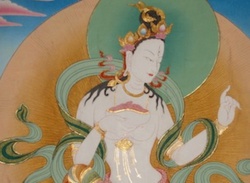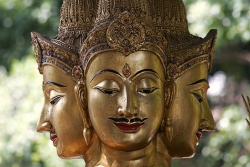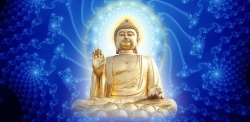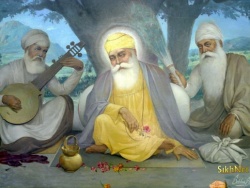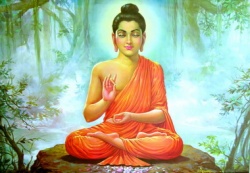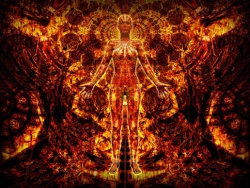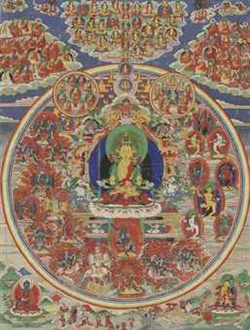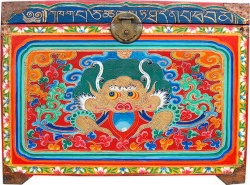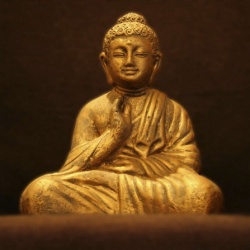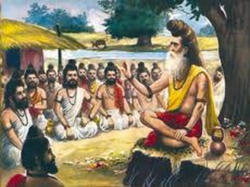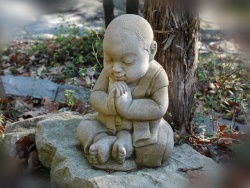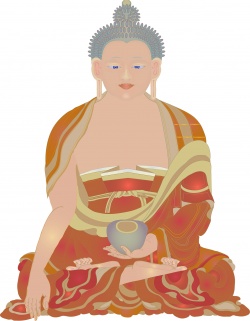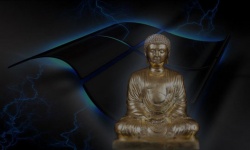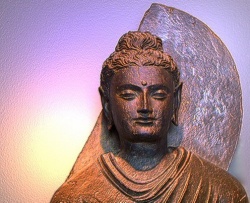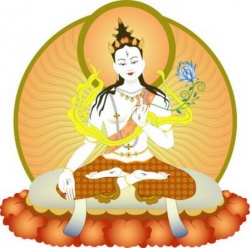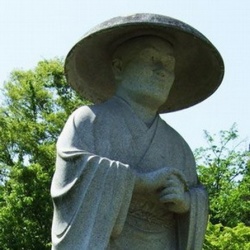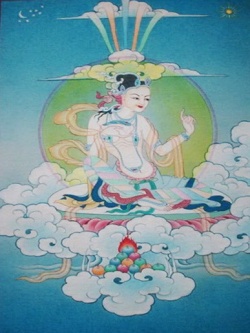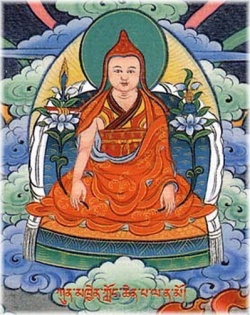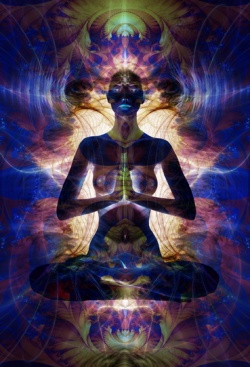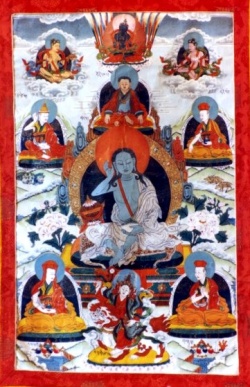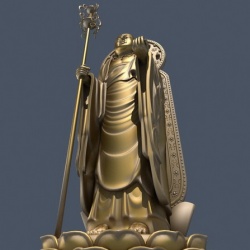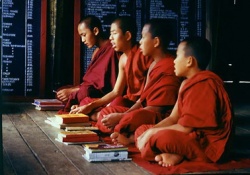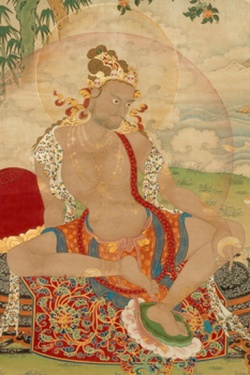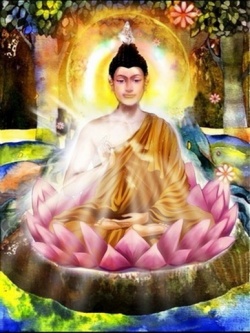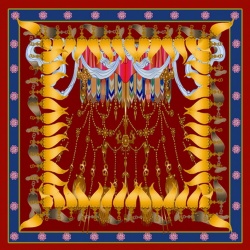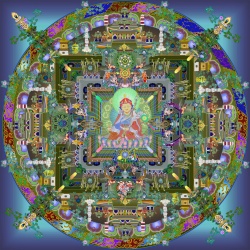Difference between revisions of "Kalachakra: The Public and the Secret Initiations"
m (Text replacement - "[[[" to "([[") |
m (Text replacement - "]]]" to "]])") |
||
| Line 41: | Line 41: | ||
The [[Kalachakra Tantra]] is explicitly modeled upon the [[traditional]] [[Indian]] {{Wiki|coronation}} {{Wiki|ceremony}} (Rajasuya). Just as the Rajasuya authorizes the heir to the [[throne]] to take on the {{Wiki|status}} of a [[king]], so the [[tantric]] [[initiation]] [[empowers]] the {{Wiki|adept}} to [[function]] as the [[emanation]] of a [[Buddhist]] [[deity]]. Of course, it is also not as a [[person]] that the [[lama]] communicates the [[divine]] energies to the initiand, but rather as a superhuman being in [[human]] [[form]]. | The [[Kalachakra Tantra]] is explicitly modeled upon the [[traditional]] [[Indian]] {{Wiki|coronation}} {{Wiki|ceremony}} (Rajasuya). Just as the Rajasuya authorizes the heir to the [[throne]] to take on the {{Wiki|status}} of a [[king]], so the [[tantric]] [[initiation]] [[empowers]] the {{Wiki|adept}} to [[function]] as the [[emanation]] of a [[Buddhist]] [[deity]]. Of course, it is also not as a [[person]] that the [[lama]] communicates the [[divine]] energies to the initiand, but rather as a superhuman being in [[human]] [[form]]. | ||
| − | It is the pupil’s [[duty]] to [[imagine]] his [[guru]] as a living [[Buddha]] ([[Tibetan]] [[Kundun]]) during the entire {{Wiki|initiatory}} process. So that he never forgets the superhuman [[nature]] of his [[master]], the [[Kalachakra Tantra]] prescribes a [[Guruyoga]] liturgy, which is to be recited by the initiand at least three times a day and three times per night. Several of these liturgies are hundreds of pages long (Mullin, 1991, p. 109). But in all of them words to the following effect can be found, with which the [[lama]] demands the pupil’s ([[sadhaka]]) [[absolute]] {{Wiki|obedience}}: “From henceforth I am your ([[deity]] | + | It is the pupil’s [[duty]] to [[imagine]] his [[guru]] as a living [[Buddha]] ([[Tibetan]] [[Kundun]]) during the entire {{Wiki|initiatory}} process. So that he never forgets the superhuman [[nature]] of his [[master]], the [[Kalachakra Tantra]] prescribes a [[Guruyoga]] liturgy, which is to be recited by the initiand at least three times a day and three times per night. Several of these liturgies are hundreds of pages long (Mullin, 1991, p. 109). But in all of them words to the following effect can be found, with which the [[lama]] demands the pupil’s ([[sadhaka]]) [[absolute]] {{Wiki|obedience}}: “From henceforth I am your ([[deity]]) [[Vajrapani]]. You must do what I tell you to do. You should not deride me, and if you do, ... the [[time]] of [[death]] will come, and you will fall into [[hell]]” ([[Dalai Lama XIV]], 1985, p. 242). |
Since it is the goal of every [[tantric]] [[initiation]] that the [[sadhaka]] himself achieve a transhuman {{Wiki|status}}, right from the outset of the {{Wiki|initiatory}} [[path]] he develops a “[[divine]] [[pride]]” and, as the [[First Dalai Lama]] informs us, is [[transformed]] into a “vessel” in which the [[supernatural]] energies collect (Mullin, 1991, p. 102). This is also true for the [[Kalachakra Tantra]]. | Since it is the goal of every [[tantric]] [[initiation]] that the [[sadhaka]] himself achieve a transhuman {{Wiki|status}}, right from the outset of the {{Wiki|initiatory}} [[path]] he develops a “[[divine]] [[pride]]” and, as the [[First Dalai Lama]] informs us, is [[transformed]] into a “vessel” in which the [[supernatural]] energies collect (Mullin, 1991, p. 102). This is also true for the [[Kalachakra Tantra]]. | ||
| Line 219: | Line 219: | ||
The [[guru]] now moves to the center of the circle ([[chakra]]) and performs a [[magic]] dance. Subsequently he unites with Shabdavajra in the [[divine]] [[yoga]], by inserting “the [[jewel]] of his [[vajra]]” (his {{Wiki|phallus}}) into her ([[Naropa]], 1994, p. 194). After he has withdrawn his member again, in the words of [[Naropa]], the following happens: “'He places his [[vajra]] [{{Wiki|phallus}}], which is filled with semen in the {{Wiki|mouth}} [of the pupil]'. After that the [[master]] gives him his own [[mudra]], whom he has already embraced” ([[Naropa]], 1994, p. 1994,195). On the basis of the texts before us we have been unable to determine whether or not the pupil now couples with the girl. This part of the [[ritual]] is referred to as the vase [[initiation]] and [[forms]] the twelfth [[initiation]] level. | The [[guru]] now moves to the center of the circle ([[chakra]]) and performs a [[magic]] dance. Subsequently he unites with Shabdavajra in the [[divine]] [[yoga]], by inserting “the [[jewel]] of his [[vajra]]” (his {{Wiki|phallus}}) into her ([[Naropa]], 1994, p. 194). After he has withdrawn his member again, in the words of [[Naropa]], the following happens: “'He places his [[vajra]] [{{Wiki|phallus}}], which is filled with semen in the {{Wiki|mouth}} [of the pupil]'. After that the [[master]] gives him his own [[mudra]], whom he has already embraced” ([[Naropa]], 1994, p. 1994,195). On the basis of the texts before us we have been unable to determine whether or not the pupil now couples with the girl. This part of the [[ritual]] is referred to as the vase [[initiation]] and [[forms]] the twelfth [[initiation]] level. | ||
| − | In the secret [[initiation]] (13) which now follows, “the [[master]] must lay his own [[vajra]] [{{Wiki|phallus}}] in the {{Wiki|mouth}} of the pupil’s wife and, whilst the pupil is blindfolded, he [the [[guru]] | + | In the secret [[initiation]] (13) which now follows, “the [[master]] must lay his own [[vajra]] [{{Wiki|phallus}}] in the {{Wiki|mouth}} of the pupil’s wife and, whilst the pupil is blindfolded, he [the [[guru]])must suck upon the Naranasika of the [[wisdom]] [[consort]]” ([[Naropa]], 1994, p. 195). Translated from [[Sanskrit]], naranasika means ‘clitoris’. “Then,” [[Naropa]] continues, “the [[master]] must give his own [[mudra]] to the pupil with the [[idea]] that she is his wife” ([[Naropa]], 1994, p. 195). This passage remains a little unclear, since he has already given a [[mudra]] to the pupil as “wife” during the preceding vase [[initiation]] (12). |
During the following [[wisdom]] [[initiation]] (14), the [[sadhaka]], surrounded by the remaining women, unites firstly with the [[mudra]] which the [[guru]] has let him have. But it does not remain just the one. “Since it is a matter of ten [[mudras]], the [[master]] must offer the pupil as many of them as he is able to sexually possess, and that in two periods of 24 minutes each, beginning from midnight until the {{Wiki|sun}} rises”, [[Naropa]] reports ([[Naropa]], 1994, p. 195). He thus has tenfold {{Wiki|sexual}} intercourse in the presence of the [[master]] and the remaining women. | During the following [[wisdom]] [[initiation]] (14), the [[sadhaka]], surrounded by the remaining women, unites firstly with the [[mudra]] which the [[guru]] has let him have. But it does not remain just the one. “Since it is a matter of ten [[mudras]], the [[master]] must offer the pupil as many of them as he is able to sexually possess, and that in two periods of 24 minutes each, beginning from midnight until the {{Wiki|sun}} rises”, [[Naropa]] reports ([[Naropa]], 1994, p. 195). He thus has tenfold {{Wiki|sexual}} intercourse in the presence of the [[master]] and the remaining women. | ||
| Line 239: | Line 239: | ||
Albert Grünwedel believed that the {{Wiki|female}} partners of the [[gurus]] were originally sacrificed at the [[Ganachakra]] and in fact were burned at the stake like {{Wiki|European}} witches so as to then be resurrected as “[[dakinis]]”, as [[tantric]] [[Wikipedia:demon|demonesses]]. His {{Wiki|hypothesis}} is difficult to confirm on the basis of the available historical {{Wiki|evidence}}. Nonetheless, as far as the [[symbolic]] significance of the [[ritual]] is concerned, we can safely assume that we are here dealing with a sacrificial {{Wiki|ceremony}}. For example, [[Buston]] (14th century), in connection with the [[highest]] [[Kalachakra]] [[initiations]] and thus also in [[relation]] to the [[Ganachakra]], speaks of “secret {{Wiki|victims}}” (Herrmann-Pfand, 1992, p. 386). The ten [[karma]] [[mudras]] present during the [[ritual]] go by the [[name]] of “sacrificial [[goddesses]]”. One event in the [[Ganachakra]] proceedings is known as “{{Wiki|sacrifice}} of the assembly”, which can only have meant the {{Wiki|sacrifice}} of the women present (Herrmann-Pfand, 1992, p. 386). A further interpreter of the [[tantras]], [[Abhinavagupta]], refers to the [[Ganachakra]] as the “{{Wiki|sacrifice}} of the [[wheel]]” ([[chakra]] means ‘[[wheel]]’) or as the “[[highest]] {{Wiki|sacrifice}}” ([[Naropa]], 1994, p. 46). | Albert Grünwedel believed that the {{Wiki|female}} partners of the [[gurus]] were originally sacrificed at the [[Ganachakra]] and in fact were burned at the stake like {{Wiki|European}} witches so as to then be resurrected as “[[dakinis]]”, as [[tantric]] [[Wikipedia:demon|demonesses]]. His {{Wiki|hypothesis}} is difficult to confirm on the basis of the available historical {{Wiki|evidence}}. Nonetheless, as far as the [[symbolic]] significance of the [[ritual]] is concerned, we can safely assume that we are here dealing with a sacrificial {{Wiki|ceremony}}. For example, [[Buston]] (14th century), in connection with the [[highest]] [[Kalachakra]] [[initiations]] and thus also in [[relation]] to the [[Ganachakra]], speaks of “secret {{Wiki|victims}}” (Herrmann-Pfand, 1992, p. 386). The ten [[karma]] [[mudras]] present during the [[ritual]] go by the [[name]] of “sacrificial [[goddesses]]”. One event in the [[Ganachakra]] proceedings is known as “{{Wiki|sacrifice}} of the assembly”, which can only have meant the {{Wiki|sacrifice}} of the women present (Herrmann-Pfand, 1992, p. 386). A further interpreter of the [[tantras]], [[Abhinavagupta]], refers to the [[Ganachakra]] as the “{{Wiki|sacrifice}} of the [[wheel]]” ([[chakra]] means ‘[[wheel]]’) or as the “[[highest]] {{Wiki|sacrifice}}” ([[Naropa]], 1994, p. 46). | ||
| − | Everything which we have said about the “[[tantric]] {{Wiki|female}} {{Wiki|sacrifice}}” is without [[doubt]] also true for the [[Ganachakra]]. There are documents which prove that such sacrifices were really carried out. In the eleventh century a group of the notorious “robber [[monks]]” became prominent, of whom the following can be read in the [[Blue Annals]]: “The [[doctrine]] of the eighteen [robber [[monks]] | + | Everything which we have said about the “[[tantric]] {{Wiki|female}} {{Wiki|sacrifice}}” is without [[doubt]] also true for the [[Ganachakra]]. There are documents which prove that such sacrifices were really carried out. In the eleventh century a group of the notorious “robber [[monks]]” became prominent, of whom the following can be read in the [[Blue Annals]]: “The [[doctrine]] of the eighteen [robber [[monks]]) consisted of a corrupt [[form]] of the [[tantric]] praxis, they kidnapped women and men and were in the [[Wikipedia:Habit (psychology)|habit]] of performing [[human]] sacrifices during the [[tantric]] feasts ([[ganacakra]] - [[puja]])” ([[Blue Annals]], 1995, p. 697). Such excesses were criticized already by the [[traditional]] [[Tibetan]] {{Wiki|historians}}, albeit with a certain leniency. Thus the [[Fifth Dalai Lama]], who himself wrote a history of [[Tibet]], exonerated the [[guru]] of the eighteen robber [[monks]], Prajnagupta by [[name]], of all [[guilt]], whilst he condemned his “pupils” as the guilty party (Herrmann-Pfand, 1992, p. 418, note 11). |
| − | Obviously, a [[Buddhist]] [[Ganachakra]] is always led by a man. Yet, like much in [[Tantrism]], this [[ritual]] also seems to have had a {{Wiki|matriarchal}} origin. The {{Wiki|Indologist}} Marie-Thérèse de Mallmann describes in detail such a gynocentric “circle feast” from the sixth century. It was staged by a powerful {{Wiki|oriental}} [[Wikipedia:Queen consort|queen]]. In one document it is said of her that, “through her [the [[Wikipedia:Queen consort|queen]] | + | Obviously, a [[Buddhist]] [[Ganachakra]] is always led by a man. Yet, like much in [[Tantrism]], this [[ritual]] also seems to have had a {{Wiki|matriarchal}} origin. The {{Wiki|Indologist}} Marie-Thérèse de Mallmann describes in detail such a gynocentric “circle feast” from the sixth century. It was staged by a powerful {{Wiki|oriental}} [[Wikipedia:Queen consort|queen]]. In one document it is said of her that, “through her [the [[Wikipedia:Queen consort|queen]]), the circle [[king]] was reduced to the role of a {{Wiki|sacrifice}} which was performed in the circle ([[chakra]]) of the [[goddesses]]” (Mallmann, 1963, p. 172). It thus involved the carrying out of a [[king]] {{Wiki|sacrifice}}, found in many {{Wiki|ancient}} {{Wiki|matriarchal}} cultures, in which the old [[king]] was replaced by a new one. The sacrificial victim here is at any rate a man. In the [[Ganachakra]] of [[Buddhist]] [[Tantrism]] precisely the opposite took place! The [[yoginis]] are sacrificed and the [[guru]] elevates himself to the triumphant [[king]] of the circle. |
The gynocentric [[ritual]] was also known under the names of “[[wheel]] of the [[goddesses]]”, “[[wheel]] of the mother” or “[[wheel]] of the witches”. Its wide distribution in the fifth and sixth centuries, above all in [[Kashmir]], supports our above {{Wiki|hypothesis}}, that there was a powerful reawakening of old {{Wiki|matriarchal}} cults in [[India]] during this period. | The gynocentric [[ritual]] was also known under the names of “[[wheel]] of the [[goddesses]]”, “[[wheel]] of the mother” or “[[wheel]] of the witches”. Its wide distribution in the fifth and sixth centuries, above all in [[Kashmir]], supports our above {{Wiki|hypothesis}}, that there was a powerful reawakening of old {{Wiki|matriarchal}} cults in [[India]] during this period. | ||
Latest revision as of 23:00, 3 April 2016
The Kalachakra Tantra (Time Tantra) is considered the last and most recent of all the revealed tantra texts (c. tenth century), yet also as the “highest of all Vajrayana ways”, “the pinnacle of all Buddhist systems”. It differs from earlier tantras in its encyclopedic character. It has been described as the “most complex and profound statement on both temporal and spiritual matters” (Newman, 1985, p. 31). We can thus depict it as the summa theologia of Buddhist Tantrism, as the root and the crown of the teaching, the chief tantra of our “degenerate era” (Newman, 1985, p. 40). Tsongkhapa (1357-1419), the significant reformer and founder of the Tibetan Gelugpa order, was of the opinion that anybody who knew the Kalachakra Tantra mastered all other secret Buddhist teachings without effort.
Even though all Tibetan schools practice the Kalachakra Tantra, there have always only been individual experts who truly command this complicated ritual. For the Yellow Hats (Gelugpa), these are traditionally the Dalai Lama and the Panchen Lama. A small study group from the Namgyal monastery are available to assist the Dalai Lama in executing the ceremonies with technical knowledge.
The ritual consists of a public part and a secret part, staged by the participants behind closed doors. Pupils with little prior knowledge or even people with none may participate in the public initiations. In contrast, the secret initiations are only accessible for the chosen few.
Despite the elitist selection, the texts sometimes suggest that the possibility of reaching the highest level of enlightenment in the Kalachakra Tantra within a single lifetime lies open to everybody. The reality is otherwise, however. Of the hundreds who participate in a public event, one commentary states, in the end only one will say his daily prayer. Of the thousands just one will commence with the yoga praxis which belong to this tantra and of these, only a handful will be initiated into the most secret initiations (Mullin, 1991, p. 28). In the Vimalaprabha, the earliest commentary upon the original text, it is stated in unmistakable terms that laity (non-monks) may absolutely not set foot upon the path to enlightenment (Newman, 1987, p. 422).
But even if the supreme goal remains closed to him, every participant ought nevertheless to gain numerous spiritual advantages for himself from the ritual mass events. According to statements by the Dalai Lama, karmic stains may thus be removed and new seeds for good karma begin to grow. The eager are beckoned by the prospect of rebirth in Shambhala, a paradise closely associated with the Kalachakra myth. At any rate the pupil has “ the opportunity to bask in the bright rays of spiritual communion with the initiating lama, in this case His Holiness the Dalai Lama, and hopefully to absorb a sprinkling of spiritual energy from the occasion” (Mullin, 1991, p. 28). Since, according to the official version, the celebrant guru conducts the Kalachakra ritual for, among other things, the “liberation of all of humanity” and the “maintenance of world peace”, both the masses present at the spectacle and the individual initiates participate in this highly ethical setting of goals (Newman, 1987, p. 382).
Fundamentally, the Buddhist tantras are subdivided into father tantras, mother tantras, or non-dual tantras. In father tantras it is principally the “method” of creation of a divine form body (vajrakaya) with which the yogi identifies which is taught. Hence the production of the self as a divinity is central here. To this end the following negative attributes of the adept need to be transformed: aggression, desire, and ignorance.
The mother tantras primarily lay worth upon the creation of a state of emptiness and unshakable bliss, as well as upon the calling forth of the clear light. Here the yogi exclusively employs the transformation of sexual desire as a means.
The non-dual tantras are a combination of father tantras and mother tantras. The “creation of a divine form body” is thus combined with the “calling forth of the clear light” and “blissful emptiness”. Thus, the yogi wants to both appear as a powerful deity and attain the ability to rest unconditionally in a state equivalent to nirvana and to bathe himself in mystic light.
Since the Kalachakra Tantra promises all these possibilities of enlightenment, the famous Tibetan scribe, Buston (1290-1364), classified it as a non-dual tantra. His opinion did not remain uncontested, however. Another outstanding expert on the rituals, Kay-drup-jay (1385-1438) described it, as do the majority of Gelugpa authors, as a mother tantra.
A further classification subdivides the “Time Tantra” into an external, internal, and alternative section.
The “external” tantra describes the formation and destruction of the universe, includes treatises on astronomy and geography, and concerns itself with the history of the world, with prophecies and religious wars. The reports on the magic realm of Shambhala are of great importance here. Emphasis is also placed upon astrology and the mathematical calculations connected with it. The entire national calendar and time-keeping methods of the Tibetans are derived from the astronomical and astrological system in the Kalachakra.
In contrast, the “internal” Kalachakra treats the anatomy of energy in the mystic body. From a tantric viewpoint, the body of every person is composed of not just flesh and blood but also a number of energy centers which are connected to one another by channels. Fluids, secretions, and “winds” flow through and pervade this complex network. Among the secretions, male semen and female menstrual blood play an important role.
In the “alternative” Kalachakra we get to know the techniques with which the yogi calls up, dissolves, or regulates these inner energy currents as needed. Further, how these can be brought into a magic relation to the phenomena of the external Kalachakra (sun, moon, and stars ...) is also taught here.
Since the Time Tantra belongs to the highest secret teachings (Anuttara Yoga Tantra), it may only be practiced by a chosen few. In the introduction to a contemporary commentary by Ngawang Dhargyey, we can thus read the following: “Sale and distribution of this book is restricted. We urgently request that only initiates into Highest Yoga Tantra and preferably into the Kalachakra system itself should read it. This caution is customary to the tradition, but to disregard it can only be detrimental” (Dhargyey, 1985, p. iii).
Such threatening gestures are a part of occult show business, then these days it is no longer even necessary to understand Tibetan or Sanskrit in order to dip into the tantras, since numerous texts plus their commentaries have been translated into European languages and are generally accessible. Even Dhargyey’s “forbidden” text (A Commentary on the Kalachakra Tantra) can be found in large public libraries. David Snellgrove, an outstanding and incorruptible interpreter of Tibetan religious history, snidely remarks of the widespread secretiveness also promoted by the lamas that, “There is nothing particularly secret about sexual yoga in the Highest Yoga Tantras; one merely has to read the texts” (Snellgrove, 1987, vol. 1, p. 269).
This was in fact different in the Tibet of old. The highest yoga teachings were not allowed to be printed, and could at best be distributed in handwriting instead. Even for monks it was very difficult to receive higher initiations, and these afforded a much longer preparation time than is usual in our day. Mass initiations were, in contrast to the present day, extremely rare occasions.
The seven lower public initiations and their symbolic significance
Let us now turn to the various stages of initiation treated in the Kalachakra Tantra and their features and methods. What can be understood by the term initiation (abhisheka)? It concerns the transmission of spiritual energies and insights from a priest to an individual who has requested this of him. The initiation thus presupposes a hierarchical relationship. In its classic form, a master (guru or lama) communicates his knowledge and mystic powers to a pupil (sadhaka). This master too once sat facing his own guru before the latter likewise initiated him. The chains of the initiated, all of which can be traced back to the historical Buddha, are known as “transmission lines”. It is usual for the transmission to proceed orally, from ear to ear. This is thus also known as the “ear-whispered lineage” (Beyer, 1978, p. 399). But words are in no sense a necessity. The initiation can also proceed without speech, for example through hand gestures or the display of symbolic images.
Both forms of transmission (the oral and the nonverbal) still take place between humans. When, however, the Buddhist deities initiate the pupil directly, without a physical go-between, this is known as the “consciousness lineage of the victors”. The transcendent Buddhas (Dhyani Buddhas) who approach an earthly adept directly are referred to as “victors”. A subtype of such communication from beyond is known as the “trust lineage of the dakinis”. Here an adept discovers holy texts which were hidden for him in caves and mountain clefts by the dakinis in times of yore in order to instruct him following their discovery. Such “consciousness treasures”, also known as termas, generally provoked sharp criticism from the orthodox lamas, as they called into question their privilege of being the only source of initiation.
The Kalachakra Tantra is explicitly modeled upon the traditional Indian coronation ceremony (Rajasuya). Just as the Rajasuya authorizes the heir to the throne to take on the status of a king, so the tantric initiation empowers the adept to function as the emanation of a Buddhist deity. Of course, it is also not as a person that the lama communicates the divine energies to the initiand, but rather as a superhuman being in human form.
It is the pupil’s duty to imagine his guru as a living Buddha (Tibetan Kundun) during the entire initiatory process. So that he never forgets the superhuman nature of his master, the Kalachakra Tantra prescribes a Guruyoga liturgy, which is to be recited by the initiand at least three times a day and three times per night. Several of these liturgies are hundreds of pages long (Mullin, 1991, p. 109). But in all of them words to the following effect can be found, with which the lama demands the pupil’s (sadhaka) absolute obedience: “From henceforth I am your (deity) Vajrapani. You must do what I tell you to do. You should not deride me, and if you do, ... the time of death will come, and you will fall into hell” (Dalai Lama XIV, 1985, p. 242).
Since it is the goal of every tantric initiation that the sadhaka himself achieve a transhuman status, right from the outset of the initiatory path he develops a “divine pride” and, as the First Dalai Lama informs us, is transformed into a “vessel” in which the supernatural energies collect (Mullin, 1991, p. 102). This is also true for the Kalachakra Tantra.
The self-sacrifice of the pupil
But doesn’t a metaphysical contest now arise between the deity which stands behind the guru and the newly created pupil deity? This is not the case for two reasons. On the one hand, the divine being behind master and pupil forms a unity. One could even consider it characteristic of divine entities that they are simultaneously able to appear in various forms. On the other, it is not the pupil (sadhaka) who produces the deity; in contrast, he absolutely and completely loses his human individuality and transforms himself into “pure emptiness”, without having to surrender his perceivable body in the process. This empty body of the sadhaka is then in the course of the initiation occupied by the deity or the lama respectively. Chögyam Trungpa has expressed this in unmistakable terms: “If we surrender our body to the guru we are surrendering our primal reference point. Our body becomes the possession of the lineage; it is not ours any more. ... I mean that surrendering our body, psychologically our dear life is turned over to someone else. We do not have our dear life to hold any more” (June Campbell, 1996, p. 161). The pupil has completely ceased to exist as an individual soul and mind. Only his body, filled by a god or respectively by his guru, visibly wanders through the world of appearances.
The Kalachakra Tantra describes this process as an “act of swallowing” which the lama performs upon the initiand. In a central drama of the Time Tantra which is repeated several times, the oral destruction of the sadhaka is graphically demonstrated, even if the procedure does only take place in the imagination of the cult participants. The following scene is played out: the guru, as the Kalachakra deity, swallows the pupil once he has been melted down to the size of a droplet. As a drop the initiand then wanders through the body of his masters until he reaches the tip of his penis. From there the guru thrusts him out into the vagina and womb of Vishvamata, the wisdom consort of Kalachakra. Within Vishvamata’s body the pupil as drop is then dissolved into “nothingness”. The rebirth of the sadhaka as a Buddhist deity takes place only after this vaginal destruction. Since the androgyne vajra master simultaneously represents Kalachakra and Vishvamata within one individual and must be imagined by the adept as “father–mother” during the entire initiation process, he as man takes over all the sex-specific stages of the birth process — beginning with the ejaculation, then the conception, the pregnancy, up to the act of birth itself. [1]
In a certain sense, through the use of his pupil’s body the guru , or at least his superhuman consciousness, achieves immortality. So long the master is still alive he has, so to speak, created a double of himself in the form of the sadhaka; if he dies then his spirit continues to exist in the body of his pupil. He can thus reproduce himself in the world of samsara for as long as there are people who are prepared for his sake to sacrifice their individuality and to surrender him their bodies as a home.
Accordingly, Tantrism does not develop the good qualities of a person in order to ennoble or even deify them; rather, it resolutely and quite deliberately destroys all the “ personality elements” of the initiands in order to replace them with the consciousness of the initiating guru and of the deity assigned to him. This leads at the end of the initiatory path to a situation where the tantra master now lives on in the form of the pupil. The latter has de facto disappeared as an individual, even if his old physical body can still be apprehended. It has become a housing in which the spirit of his master dwells.
The lineage tree
The pupil serves as an empty vessel into which can flow not just the spirit of his master but also the lineage of all the former teachers which stretches back behind him, plus the deities they have all represented. It is all of these who now occupy the sadhaka’s body and through him are able to function in the real world.
In Lamaism, once anyone counts as part of the lineage of the High Initiates, they become part of a “mystic tree” whose leaves, branches, trunk, and roots consist of the numerous Buddhas and Bodhisattvas of the Tibetan/tantric pantheon. At the tip or in the middle of the crown of the tree the Highest Enlightenment Being (the ADI BUDDHA) is enthroned, who goes by different names in the various schools. The divine energy flows from him through every part to deep in the roots. Evans-Wentz compares this down-flow to an electric current: “As electricity may be passed on from one receiving station to another, so ... is the divine Grace ... transmitted through the Buddha Dorje Chang (Vajradhara) to the Line of Celestial Gurus and thence to the Apostolic Gurus on earth, and from him, to each of the subordinate Gurus, and by them, through the mystic initiation, to each of the neophytes” (Evans-Wentz, 1978, p. 9, quoted by Bishop, 1993, p. 118).
All of the high initiates are separated by a deep divide from the masses of simple believers and the rest of the suffering beings, who either prostrate themselves before the dynastic line tree in total awe or are unable to even perceive it in their ignorance. Yet there is still a connection between the timeless universe of the gurus and “normal” people, since the roots of the mystic tree are anchored in the same world as that in which mortals live. The spiritual hierarchy draws its natural and spiritual resources from it, both material goods and religious devotion and loving energy. The critical Tibet researcher, Peter Bishop, has therefore, and with complete justification, drawn attention to the fact that the mystic line tree in Lamaism takes on the appearance of a bureaucratic, regulated monastic organization: “This idealized image of hierarchical order, where everything is evaluated, certified and allotted a specific place according to the grade of attainment, where control, monitoring and authorization is absolute, is the root-metaphor of Tibetan Buddhism” (Bishop, 1993, p. 118).
The first seven initiations
All together the Kalachakra Tantra talks of fifteen initiatory stages. The first seven are considered lower solemnities and are publicly performed by the Dalai Lama and open to the broad masses. The other eight are only intended for a tiny, select minority. The Tibetologist Alexander Wayman has drawn a comparison to the Eleusian mysteries of antiquity, the first part of which was also conducted in front of a large public, whilst only a few participated in the second, secret part in the temple at night (Wayman, 1983, 628).
The seven lower initiations ought to be succinctly described here. They areas follows: the (1) the water initiation;(2) the crown initiation; (3) the silk ribbon initiation; (4) the vajra and bell initiation; (5) the conduct initiation; (6) the name initiation; and (7) the permission initiation. All seven are compared to the developmental stages of a child from birth to adulthood. In particular they serve to purify the pupils.
Before beginning the initiatory path the neophyte swears a vow with which he makes a commitment to strive for Buddhahood incessantly, to regret and avoid all misdeeds, to lead other beings along the path to enlightenment, and to follow absolutely the directions of the Kalachakra master. But above all he must visualize his androgyne guru as the divine couple, Kalachakra in union with his consort Vishvamata. With blindfolded eyes he must imagine that he is wandering through a three-dimensional mandala (an imaginary palace) which is occupied by the four meditation Buddhas (Amitabha, Ratnasambhava, Amoghasiddhi, Vairochana) and their partners.
After his blindfold has been removed, he tosses a blossom onto a sacred image (mandala) spread out before him, which has been prepared from colored sand. The place where the flower comes to rest indicates the particular Buddha figure with which the pupil must identify during his initiation journey. In the following phase he receives two reeds of kusha grass, since the historical Buddha once experienced enlightenment as he meditated while seated on this type of grass. Further, the Lama gives him a toothpick for cleansing, as well as a red cord, which he must tie around the upper arm with three knots. Then he receives instructions for sleeping. Before he goes to bed he has to recite certain mantras as often as possible, and then to lay himself on his right side with his face in the direction of the sand mandala. Dreams are sent to him in the night which the guru analyzes another day. It is considered especially unfavorable if a crocodile swallows the pupil in his dream. The monster counts as a symbol for the world of illusions (samsara) and informs the sadhaka that he is still strongly trapped by this. But via meditation upon the emptiness of all appearances he can dissolve all unfavorable dream images again.
Further instructions and rites follow which likewise concern purification. At the end of the first seven stages the Vajra master then dissolves the pupil into “emptiness” in his imagination, in order to then visualize him as his own polar image, as Kalachakra in union with Vishvamata. We should never forget that the androgynous tantric teacher represents both time deities in one person. Since the pupil possesses absolutely no further individual existence right from the beginning of the initiation, the two time deities are doubled by this meditative imagining — they appear both in the tantra master and in the person of the sadhaka.
We can thus see that already in the first phase of the Kalachakra initiation, the alternation between dissolution and creation determines the initiatory drama. The teacher will in the course of the rituals destroy his pupil many times more in imagination, so as to replace him with a deity, or he will instruct the sadhaka to perform the individual act of destruction upon himself until nothing remains of his personality. In a figurative sense, we can describe this destruction and self-destruction of the individual as a continually performed “human sacrifice”, since the “human” must abandon his earthly existence in favor of that of a deity. This is in no sense a liberal interpretation of the tantra texts; rather it is literally demanded in them. The pupil has to offer himself up with spirit and mind, skin and hair to the guru and the gods at work through him. Incidentally, these, together with all of their divine attributes, are codified in a canon, they can no longer develop themselves and exert their influence on reality as frozen archetypal images.
In the light of the entire procedure we have described, it seems sensible to remind ourselves of the thesis posed above, that the “production” of the deity and the “destruction” of the person stand in an originally causal relation to one another, or — to put it even more clearly — that the gods and the guru who manipulates them feed themselves upon the life energies of the pupil.
The first two initiations, the water and crown initiations, are directed at the purification of the mystic body. The water initiation (1) corresponds to the bathing of a child shortly after its birth. The five elements (earth, water, fire, air, and ether) become purified in the energy body of the sadhaka. Subsequently, the guru in the form of Kalachakra imagines that he swallows the initiand who has melted down to the size of a droplet, then thrusts him out through his penis into the womb of his partner Vishvamata, who finally gives birth to him as a deity. As already mentioned above, in this scenario of conception and birth we must not lose sight of the fact that the androgynous guru simultaneously represents in his person the time god and the time goddess. The complete performance is thus set in scene by him alone. At the close of the water initiation the master touches the initiand at the “five places” with a conch shell: the crown, the shoulder, the upper arm, the hip and the thigh. Here, the shell is probably a symbol for the element of water.
The crown initiation (2) which now follows corresponds to the child’s first haircut. Here the so-called “five aggregates” of the pupil are purified (form, feeling, perception, unconscious structures, consciousness). By “purification” we must understand firstly the dissolving of all individual personality structures and then their “re-creation” as the characteristics of a deity. The procedure is described thus in the tantra texts; however, to be exact it is not a matter of a “re-creation” but of the replacement of the pupil’s personality with the deity. At the end of the second initiation the vajra master touches the “five places” with a crown.
The third and fourth initiations are directed at the purification of speech. In the silk ribbon initiation (3), the androgynous guru once more swallows the pupil and — in the form of Vishvamata — gives birth to him as a god. Here the energy channels, which from a tantric way of looking at things constitute the “mystic framework” of the subtle body, are purified, that is dissolved and created anew. In the development of the human child this third initiation corresponds to the piercing of the ears, so that a golden ring can be worn as an adornment.
The vajra and bell initiation (4) follows, which is compared to the speaking of a child’s first words. Now the guru cleanses the three “main energy channels” in the pupil’s body. They are found alongside the spine and together build the subtle backbone of the adept, so to speak. The right channel becomes the masculine vajra, the left the feminine bell (gantha). In the middle, “androgynous” channel both energies, masculine and feminine, meet together and generate the so-called “mystic heat”, which embodies the chief event in the highest initiations, to be described in detail later. The pupil now asks the Kalachakra deity, represented through the guru, to give him the vajra and the bell, that is, to hand over to him the emblems of androgyny.
Yet again, an act of swallowing takes place in the fifth initiation. The conduct initiation (5) corresponds to a child’s enjoyment of the objects of the senses. Accordingly, the six senses (sight, hearing, smell, etc.) and their objects (image, sound, scent, etc.) are destroyed in meditation and re-created afterwards as divine characteristics. The vajra master ritually touches the pupil’s “five places” with a thumb ring.
In the name initiation (6) which follows, the ordained receive a secret religious name, which is usually identical with that of the deity assigned to them during the preparatory rites. The guru prophecies that the pupil will appear as a Buddha in the future. Here the six abilities to act (mouth, arms, legs, sexual organs, urinary organs, and anus) and the six actions (speech, grasping, walking, copulation, urination, and defecation) are purified, dissolved and re-created. As seems obvious, the texts compare the naming of a child with the sixth initiation. The fifth and sixth initiations together purify the spirit.
The permission initiation (7) remains — which corresponds on the human level to the child’s first lesson in reading. Five symbols (the vajra, jewel, sword, lotus, and wheel) which act as metaphors for various states of awareness in deep meditation are purified, dissolved and replaced. The androgynous guru swallows the pupil once more and as Kalachakra in union with his consort gives birth to him anew. He then hands him the vajra and the bell, as well as the five symbolic objects just mentioned, one after another. A river of mantras pours from the lama’ mouth, flows over into the mouth of the pupil, and collects in his heart center. With a golden spoon the master gives him an “eye medicine”, with which he can cast aside the veil of ignorance. He then receives a mirror as an admonition that the phenomenal world is illusory and empty like a reflection in a mirror. A bow and arrow, which are additionally handed to him, are supposed to urge him on to extreme concentration.
The ritual lays especial weight on the handing over of the diamond scepter (vajra). The guru says “that the secret nature of the vajra is the exalted wisdom of great bliss. Holding the vajra will recall the true nature of the ultimate vajra, or what is called ‘method’” (Bryant, 1992, p. 165). Through this closing remark the tantra master forcefully evokes the masculine primacy in the ritual. In that the pupil crosses his arms with the vajra in his right hand and the feminine bell in his left (the Vajrahumkara gesture), he demonstrates his androgyny and his tantric ability to control the feminine wisdom energies (prajna) with “method” (upaya).
With this demonstration of dominance the seven lower initiations are ended. The adept can now describe himself as a “lord of the seventh level”. With immediate effect he gains the right to disseminate the teaching of Buddha, albeit only within the limits of the lower initiations described. The vajra master thus calls out to him, “Turn the vajra wheel (teach the Dharma) in or to help all sentient beings” (Bryant, 1992, p. 164).
In the truest sense of the word the first seven solemnities are just the “foreplay” of the Kalachakra initiation. Then only in the higher initiations which follow does it come to sexual union with a real partner. The wisdom consorts of the seven lower levels are of a purely imaginary nature and no karma mudra is needed for their performance. Therefore they can also be given in public, even in front of great crowds.
The divine time machine
So far, the vajra master and his pupil appear as the sole protagonists on the initiatory stage of the Time Tantra. Predominant in all seven initiation scenes is the uninterrupted consolidation of the position of the master, primarily depicted in the act of swallowing and rebirth of the initiand, that is, in his destruction as a human and his “re-creation” as a god. We can therefore describe the “death of the pupil” and his “birth as a deity” as the key scene of the tantric drama, constantly repeated on all seven lower initiation levels. The individual personality of the sadhaka is destroyed but his visible body is retained. The guru uses it as a living vessel into which he lets his divine substances flow so as to multiply himself. The same gods now live in the pupil and the master.
But is there no difference between the guru and the sadhaka any more after the initiation? This is indeed the case when both are at the same level of initiation. But if the master has been initiated into a higher stage, then he completely encompasses the lower stage at which the pupil still finds himself. For example, if the initiand has successfully completed all seven lower solemnities of the Kalachakra Tantra yet the Kalachakra master is acting from the eighth initiation stage, then the pupil has become a part of the initiating guru, but the guru is in no sense a part of the pupil, since his of spiritual power skills are far higher and more comprehensive.
The initiation stages and the individuals assigned to them thus stand in a classic hierarchical relation to one another. The higher always integrate the lower, the lower must always obey the higher, those further down are no more than the extended arm of those above. Should, for example — as we suspect — the Dalai Lama alone have attained the highest initiation stage of the Kalachakra Tantra, then all the other Buddhists initiated into the Time Tantra would not simply be his subordinates in a bureaucratic sense, but rather outright parts of his self. In his system he would be the arch-god (the ADI BUDDHA), who integrated the other gods (or Buddhas) within himself, then since all individual and human elements of the initiand are destroyed, there are only divine beings living in the body of the pupil. But these too stand in a ranked relationship to one another, as there are lower, higher and supreme deities. We thus need — to formulate things somewhat provocatively — to examine whether the Kalachakra Tantra portrays a huge divine time machine with the Dalai Lama as the prime mover and his followers as the various wheels.
The four higher “secret” initiations
The seven lower initiations are supposed to first “purify” the pupil and then transform him into a deity. For this reason they are referred to as the “stage of production”. The following “four higher initiations” are considered to be the “stage of perfection”. They are known as: (8) the vase initiation; (9) the secret initiation; (10) the wisdom initiation; and (11) the word initiation. They may only be received under conditions of absolute secrecy by a small number of chosen.
In all of the higher initiations the presence of a young woman of ten, twelve, sixteen, or twenty years of age. Without a living karma mudra enlightenment cannot, at least according to the original text, be attained in this lifetime. The union with her thus counts as the key event in the external action of the rituals. Thus, as the fourth book of the Kalachakra Tantra says with emphasis, “neither meditation nor the recitation of mantras, nor the preparation, nor the great mandalas and thrones, nor the initiation into the sand mandala, nor the summonsing of the Buddhas confers the super natural powers, but alone the mudra” (Grünwedel, Kalacakra IV, p. 226).
Further, in the higher initiations the adept is obliged to ritually consume the five types of meat (human flesh, elephant meat, horseflesh, dog, and beef) and drink the five nectars (blood, semen, menses ...).
In texts which are addressed to a broad public the vase initiation (8) is euphemistically described as follows. The vajra master holds a vase up before the sadhaka’s eyes. The adept visualizes a sacrificial goddess who carries the vase. The vessel is filled with a white fluid (Henss, 1985, p. 51). In reality, however, the following initiation scene is played out: firstly the pupil brings the lama a “beautiful girl, without blemish”, twelve years of age. He then supplicates to receive initiation and sings a hymn of praise to his guru. “Satisfied, the master then touches the breast of the mudra in a worldly manner” (Naropa, 1994, p. 190). This all takes place before the pupil’s watchful gaze, so as to stimulate the latter’s sexual desire.
According to another passage in the texts — but likewise in reference to the Kalachakra Tantra — the vajra master shows the undressed girl to the sadhaka and requires him to now stroke the breasts of the karma mudra himself (Naropa, 1994, p. 188). “There is not actually any vase or any pot that is used for this empowerment”, we are informed by Ngawang Dhargyey, a modern commentator on the Time Tantra. “What is referred to as ‘the pot’ are the breasts of the girl, which are called the ‘vase that holds the white’” (Dhargyey, 1985, p. 8). We have already drawn attention to the fact that this white substance is probably the same magic secretion from the female breast which the European alchemists of the seventeenth century enthusiastically described as “virgin’s milk” and whose consumption promised great magical powers for the adept.
The sight of the naked girl and the stroking of her breasts causes the “descent” of the semen virile (male seed) in the pupil. In the tantric view of things this originally finds itself at a point below the roof of the skull and begins to flow down through the body into the penis when a man becomes sexually aroused. Under no circumstances may it come to the point of ejaculation here! If the pupil successfully masters his lust, he attains the eighth initiation stage, which is known as the “immobile” on the basis of the fixation of the semen in the phallus.
Let us now continue with the euphemistic depiction of the next secret initiation (9): The pupil is blindfolded. The master unites the masculine and feminine forces within himself and subsequently lets the adept taste the “mystic nectar”, which is offered to him in the form of tea and yogurt so that he may experience great bliss (Henss, 1985, p. 52). In reality something different is played out on this level: firstly the adept hands valuable clothes and other sacrificial offerings over to the master. Then he presents him with a young and gracile girl. The lama demands that the sadhaka leave the room or blindfold himself. Tantric dishes are served, the master venerates and praises the mudra with songs of adulation, elevates her to the status of a goddess and then couples with her “until her sexual fluids flow” (Farrow and Menon, 1992, p. 121). He then, exceptionally, allows his semen to flow into her vagina.
The mixture of “red-white fluid” thus created, that is, of the male and female seed, is scooped out of the sexual organs of the wisdom consort with a finger or a small ivory spoon and collected in a vessel. The master then summons the pupil, or instructs him to remove his blindfold. He now takes some of the “holy substance” with his finger once more and moistens the tongue of the adept with it whilst speaking the words, “This is your sacrament, dear one, as taught by all Buddhas ... “ — and the pupil answers blissfully, “Today my birth has become fruitful. Today my life is fruitful. Today I have been born into the Buddha-Family. Now I am a son of the Buddhas” (Snellgrove, 1987, vol. 1, p. 272). Concretely, this means that he has, through the consumption of the female and the male seed, attained the status of an androgyne.
But there are also other versions of the second initiation. When we read that, “The pupil visualizes the secret vajra of the vajra masters in his own mouth and tastes the white bodhicitta of the guru lama. This white bodhicitta sinks to his own heart chakra and in so doing generates bliss ...The name ‘secret initiation’ is thus also a result of the fact that one partakes of the secret substance of the vajra master” (Henss, 1985, p. 53; Dhargyey, 1985, p. 8), then this in truth means that the guru lays his sperm-filled penis in the mouth of the adept and the latter tastes the semen, since the “white bodhicitta” and the “secret substance” are nothing other than the semen virile of the initiating teacher.
In the wisdom initiation (10) which follows, the pupil is confronted with an even more sexually provocative scene: “... he is told to look at the spreading vagina of a knowledge lady. Fierce passion arises in him, which in turn induces great bliss” (Dalai Lama I, 1985, p.155). The tantra master then “gives” the sadhaka the girl with the words, “O great Being, take this consort who will give you bliss” (Farrow and Menon, 1992, p. 186). Both are instructed to engage in sexual union (Naropa, 1994, pp. 188, 190). During the ritual performance of the yuganaddha (fusion) the adept may under no circumstances let go of his semen.
The Kalachakra Tantra does not give away all of the secrets which are played out during this scene. It therefore makes sense to fall back upon other tantra texts in order to gain more precise information about the proceedings during the tenth initiation stage. For example, in the Candamaharosana Tantra, once the master has left the room, the mudra now provokes the pupil with culinary obscenities: “Can you bear, my dear,” she cries out, “to eat my filth, and faeces and urine; and suck the blood from inside my bhaga [vagina]?” Then the candidate must say: “Why should I not bear to eat your filth, O Mother? I must practice devotion to women until I realize the essence of Enlightenment” (George, 1974, p. 55).
The final “word initiation” (11) is in a real sense no longer an initiation by the guru, as its name indicates it only exists in a literal form. It is thus also not revealed in any external scenario, but instead takes place exclusively within the inner subtle body of the former pupil, since the latter has already made the switch to a perfected consciousness and been transformed into a deity. A commentary upon the eleventh higher initiation thus belongs in the next chapter, which concerns the microcosmic processes in the energy body of the practitioner.
Sperm and menstrual blood as magic substances
But before we continue with a discussion of the four highest initiations, we would like to make a number of reflections on the topic of sperm gnosis, which so decisively shapes not just the Kalachakra but rather all tantras. The same name, bodhicitta, is borne by both the male seed and the supreme mystic experience, that of the “clear light”. This already makes apparent how closely interlaced the semen virile and enlightenment are. The bodhicitta ("wisdom-mind”) is characterized by the feeling of “supreme bliss” and “absolute self-awareness”. A connection between both states of consciousness and the male sperm seems to be a necessity for the tantric, since, as we may read in the Hevajra Tantra, “without semen there would be no bliss and without bliss semen would not exist. Since semen and bliss are ineffective on their own they are mutually dependent and bliss arises from the union with the deity” (Farrow and Menon, 1992, p. 169).
In the tantras, the moon and water are idiosyncratically assigned to the male seed, which is idiosyncratic because both metaphors are of largely feminine character in terms of cultural history. We will need to look into this anomaly in Tantric Buddhism later. But a solar assignation of sperm is likewise known (Bharati, 1977, p. 237). The exceptional meaning which is accorded to the semen virile in Vajrayana has given rise to the conception among the Tibetan populace that, rather than blood, male seed flows in the veins of a high lama (Stevens, 1993, p. 90).
The retention of sperm
For a Buddhist Tantric the retention of the male seed is the sine qua non of the highest spiritual enlightenment. This stands in stark opposition to the position of Galen (129–199 C.E.), the highest medical authority of the European Middle Ages. Galen was of the opinion that the retentio semenis would lead to a putrefaction of the secretion, and that the rotten substance would rise to the head and disturb the functioning of the brain.
In contrast, the tantras teach that the semen is originally stored in a moonlike bowl beneath the roof of the skull. As soon as a person begins to experience sexual desire, it starts to flow out, drop by drop, passing through the five energy centers (chakras). In each of these the yogi experiences a specific “seminal” ecstasy (Naropa, 1994, p. 191). The destination of the sperm’s journey within the body is the tip of the penis. Here, through extreme meditative concentration, the adept collects the lust: “The vajra [penis] is inserted into the lotus [vagina], but not moved. When lust of a transient art arises, the mantra hum should be spoken. ... The decisive [factor] is thus the retention of the sperm. Through this, the act obtains a cosmological dimension. ... It becomes the means of attaining enlightenment (bodhi)” (Grönbold, Asiatische Studien, p. 34). “Delight resides in the tip of the vajra [penis]", as is said in a Kalachakra text (Grönbold, 1992a).
With the topic of sperm retention an appeal is made to ancient Indian sexual practices which date from pre-Buddhist times. In the national epic poem of the Indians, the Mahabharata, we can already read of ascetics “who keep the semen up” (Grönbold, Asiatische Studien, p. 35). In early Buddhism a holy man (Arhat) is distinguished by the fact that his discharges have been conquered and in future no longer occur. From Vajrayana comes the striking saying that “A yogi whose member is always hard is one who always retains his semen” (Grönbold, Asiatische Studien, p. 34). In contrast, in India the flowing of the male seed into “the fiery maw of the female sexual organ” is still today regarded as a sacrificium and therefore feared as an element of death (White, 1996, p. 28).
The in part adventurous techniques of semen retention must be learnt and improved by the adept through constant, mostly painful, practice. They are either the result of mental discipline or physical nature, such as through pressure on the perineum at the point of orgasm, through which the spermatic duct is blocked, or one stops the seminal flow through his breathing. If it nonetheless comes to ejaculation, then the lost sperm should be removed from the mudra’s vagina with the finger or tongue and subsequently drunk by the practitioner.
Yet that which is forbidden under penalty of dreadful punishments in hell for the pupil, this is not by a long shot the case for his guru. Hence, Pundarika, the first commentator upon the Kalachakra Tantra, distinguishes between one “ejaculation, which arises out of karma and serves to perpetuate the chain of rebirth, and another, which is subject to mental control ...” (Naropa, 1994, p. 20). An enlightened one can thus ejaculate as much as he wishes, under the condition that he not lose his awareness in so doing. It now becomes apparent why the vajra master in the second higher initiation (9) of the Time Tantra is able to without harm let his sperm flow into the vagina of the mudra so as to be able to offer the mixture (sukra) which runs out to the pupil as holy food.
The female seed
As the female correspondence to male sperm the texts nominate the seed of the woman (semen feminile). Among Tantrics it is highly contested whether this is a matter of the menstrual blood or fluids which the mudra secretes during the sexual act. In any case, the sexual fluids of the man are always associated with the color white, and those of the woman with red. Fundamentally, the female discharge is assigned an equally powerful magic effect as that of its male counterpart. Even the gods thirst after it and revere the menses as the nectar of “immortality” (Benard, 1994, p. 103). In the old Indian matriarchies, and still today in certain Kali cults, the menstruating goddess is considered as one of highest forms of appearance of the feminine principle (Bhattacharyya, 1982, pp. 133, 134). It was in the earliest times a widespread opinion, taken up again in recent years by radical feminists, that the entire natural and supernatural knowledge of the goddess was concentrated in the menstrual blood.
Outside of the gynocentric and tantric cults however, a negative valuation of menstrual blood predominates, which we know from nearly all patriarchal religions: a menstruating woman is unclean and extremely dangerous. The magic radiation of the blood brings no blessings, rather it has devastating effects upon the sphere of the holy. For this reason, women who are bleeding may never enter the grounds of a temple. This idea is also widely distributed in Hinayana Buddhism. Menstrual blood is seen there as a curse which has its origins in a female original sin: “Because they are born as women,” it says in a text of the “low vehicle”, “their endeavors toward Buddhahood are little developed, while their lasciviousness and bad characteristics preponderate. These sins, which strengthen one another, assume the form of menstrual blood which is discharged every month in two streams, in that it soils not just the god of the earth but also all the other deities too” (Faure, 1994, p. 182). But the Tantrics are completely different! For them the fluids of the woman bear Lucullan names like “wine”, “honey”, “nectar”, and a secret is hidden within them which can lead the yogi to enlightenment (Shaw, 1994, p. 157)
According to the tantric logic of inversion, that precisely the worst is the most appropriate starting substance for the best, the yogi need not fear the magical destructive force of the menses, as he can reverse it into its creative opposite through the proper method. The embracing of a “bleeding” lover is therefore a great ritual privilege. In his book on Indian ecstatic cults, Philip Rawson indicates that “the most powerful sexual rite ... requires intercourse with the female partner when she is menstruating and her ‘red’ sexual energy is at its peak” (Rawson, 1973, p. 24; see also Chöpel, 1992, p. 191).
Astonishingly, the various types of menses which can be used for divergent magical purposes have been cataloged. The texts distinguish between the menstrual blood of a virgin, a lower-class woman, a married woman, a widow, and so on. (Bhattacharyya, 1982, p. 136) The time at which the monthly bleeding takes place also has ritual significance. In Tibet yiddams (meditation images) exist which illustrate dakinis from whose vaginas the blood is flowing in streams (Essen, 1989, vol. 1, p. 179).
In keeping with the Tantric’s preference for every possible taboo substance, it is no wonder that he drinks the menses. The following vision was in fact perceived by a woman, the yogini Yeshe Tsogyal, it could however have been just as easily experienced by pretty much any lama: “A red lady, perfectly naked and wearing not even a necklace of bones, appeared before me. She placed her vagina at my mouth and blood flowed out of it which I drank with deep draughts. It now appeared to me that all realms were filled with bliss! The strength, only comparable to that of a lion, returned to me!” (Herrmann-Pfand, 1992, p. 281).
As has already been mentioned, the monthly flow is not always recognized as the substance yearned for by the yogi. Some authors here also think of other fluids which the woman releases during the sexual act or through stimulation of the clitoris. “When passion is produced, the feminine fluid boils”, Gedün Chöpel, who has explored this topic intensively, tells us (Chöpel, 1992, p. 59). From him we also learn that the women guard the secret of the magic power of their discharges: “However, most learned persons nowadays and also women who have studied many books say that the female has no regenerative [?] fluid. Because I like conversation about the lower parts, I asked many women friends, but aside from shaking a fist at me with shame and laughter, I could not find even one who would give me a honest answer” (Chöpel, 1992, p. 61).
The sukra
In the traditional Buddhist conception an embryo arises from the admixture of the male seed and the female seed. This red-white mixture is referred to by the texts as sukra Since the fluids of man and woman produces new life, the following analogic syllogism appears as obvious as it is simple: if the yogi succeeds in permanently uniting within himself both elixirs (the semen virile and the semen feminile), then eternal life lies in store for him. He becomes a “born of himself”, having overcome the curse of rebirth and replaced it with the esoteric vision of immortality. With the red-white mixture he attains the “medicine of long life”, a “perfected body” (Hermanns, 1965, pp. 194, 195). Sukra is the “life juice” par excellence, the liquid essence of the entire world of appearances. It is equated with amrta, the “drink of immortality” or the “divine nectar”.
Even if many tantric texts speak only of bodhicitta, the male seed, at heart it is a matter of the absorption of both fluids, the male and the female, in short — of sukra. Admittedly the mixing of the sexual fluids does seem incompatible with the prohibition against ejaculation, but through the so-called Vajroli method the damaging consequences of the emission of semen can be reversed, indeed this is considered a veritable touchstone of the highest yogic skill. Here, the tantra master lets his bodhicitta flow into his partner‘s vagina in order to subsequently draw back into himself through his urethra the male-female mixture which has arisen there. “After he has streamed forth,” Mircea Eliade quotes a text as saying, “he draws in and says: through my force, through my seed I take your seed — and she is without seed” (Eliade, 1985, p. 264). The man thus steals the seed of the woman under the impression that he can through this become a powerful androgynous being, and leaves her without her own life energy.
Some of the “initiated” even succeed in drawing up the semen feminile without ejaculating any sperm so as to then produce the yearned-for sukra mixture in their own body. The mastery of this method requires painful and lengthy exercises, such as the introduction of small rods of lead and “short lengths of solder” into the urethra (Eliade, 1985, p. 242). Here can be seen very clearly how much of a calculating and technical meaning the term upaya (method) has in the tantras. Yet this does not hinder the Tantric Babhaha from celebrating this thieving process in a poetic stanza:
In the sacred citadel of the vulva of
a superlative, skillful partner,
do the praxis of mixing white seed
with her ocean of red seed.
Then absorb, raise, and spread the nectar—
A stream of ecstasy such as you’ve never known.
(quoted by Shaw, 1994, p. 158).
Ejaculation
Now what happens if the yogi has not mastered the method of drawing back? Fundamentally, the following applies: “Through the loss of the bindu [semen] comes death, through its retention, life” (Eliade, 1985, p. 257). In a somewhat more tolerant view, however, the adept may catch the sukra from out of the vagina in a vessel and then drink it (Shaw, 1994, p. 157). It is not rare for the drinking bowl to be made from a human skull. The Candamaharosana Tantra recommends sucking the mixture up with a tube (pipe) through the nose (George, 1974, p. 75). If one sips the sukra out of his mudra’s genitals with his mouth, then the process is described as being “from mouth to mouth” (White, 1996, p. 200). Without exaggeration one can refer to this drinking of the “white-red bodhicitta” as the great tantric Eucharist, in which semen and blood are sacredly consumed in place of bread and wine. Through this oriental “Last Supper” the power and the strength of the women are passed over to the man.
Already, centuries before Tantrism ,the nightly ejaculations of the Buddhist Arhats (holy men) were a topic of great debate. In Tantrism, a man who let his sperm flow was referred to as a pashu, an “animal”, whereas anyone who could retain it in the sexual act was a vira, a “hero”, and accorded the attribute divya, “divine” (Bharati, 1977, p. 1977 148).
We have already reported how ejaculation is equated simply with death. This too we already learn from the pre-Buddhist Upanishads. In fact, Indian culture is, in the estimation of one of its best interpreters, Doniger O’Flaherty, characterized by a deadly fear of the loss of semen far beyond the limits of the tantric milieu: “The fear of losing body fluids leads not only to retention, but to attempts to steal the partner's fluid (and the fear that the partner will try the same trick) — yet another form of competition. If the woman is too powerful or too old or too young, terrible things will happen to the innocent man who falls into her trap, a fact often depicted in terms of his losing his fluids” (O'Flaherty, 1982/1988, p. 56). Agehananda Bharati also shares this evaluation, when he writes in his book on the tantric traditions that, “the loss of semen is an old, all-pervasive fear in Indian tradition and probably the core of the strongest anxiety syndrome in Indian culture” (Bharati, 1977, p. 237).
The drawing up of sperm by a woman is viewed by a tantric yogi as a mortally dangerous theft and a fundamental crime. Is this purely a matter of male fantasies? Not at all — a gynocentric correspondence to the thieving seed-absorption is, namely, known from the Kali cults to be a ritual event. Here, the woman assumes the upper position the sex act and in certain rites leaves the man whose life energies she has drained behind as a corpse. According to statements by the Tibet researcher, Matthias Hermanns¸ there were yoginis (female yogis) who received instruction in a technique “through which they were able to forcibly draw their partners’ semen from out of the penis”, and the author concludes from this that, “It is thus the counterpart of the procedure which the yogi employs to soak up the genital juices of several women one after another through his member” (Hermanns, 1965, p. 19). The theft of the male sperm in waking and in dream likewise counts as one of the preferred entertainments of the dakinis.
Alchemy and semen gnosis
Before we continue with the initiation path in the Kalachakra Tantra, we would like to throw a brief glance over Indian alchemy and the sexual substances it employs, because this half-occult science by and large coincides with the tantric seed gnosis. The Sanskrit term for alchemy is Rasa-vada. Rasa means ‘liquid’ or ‘quicksilver’. Quicksilver was considered the most important chemical substance which was made use of in the “mystic” experiments, both in Europe and in Asia. The liquid metal was employed in the transformation of materials both in the east and the west, in particular with the intention of producing gold. In the Occident it bore the name of the Roman god, Mercury. The Kalachakra Tantra also mentions quicksilver at several points. The frequency with which it is mentioned is a result of its being symbolically equated with the male seed (bodhicitta); it was, in a manner of speaking, the natural-substance form of the semen virile.
It is a characteristic of quicksilver that it can “swallow” other substances, that is, chemically bind with them. This quality allowed the liquid metal to become a powerful symbol for the tantric yogi, who as an androgyne succeeds in absorbing — i.e., “swallowing” — the gynergy of his wisdom consort.
The corresponding feminine counterpart to mercury is sulfur, known in India as Rasa-vada, and regarded as a chemical concentrate of menstrual blood. Its magic efficacy is especially high when a woman has been fed sulfur twenty-one days before her menses. Both substances together, mercury and sulfur, create cinnabar, which, logically, is equated with sukra, the secret mixture of the male and female seed. In the Indian alchemic texts it is recommended that one drink a mixture of quicksilver and sulfur with semen and menstrual blood for a year in order to attain exceptional powers (White, 1996, p. 199).
Just how fundamental the “female seed” was for the opus of the Indian alchemists can be deduced from the following story. The yogi and adept Nagarjuna, highly revered by the Tibetans and a namesake of the famous founder of Mahayana Buddhism with whom he is often put on the same level, experimented for years in order to discover the elixir of life. Albert Grünwedel has therefore christened him the “Faust of Buddhism”. One day, fed up with his lack of success, he threw his book of formulas into the river. It was fished out by a bathing prostitute and returned to the master. He saw this as a higher sign and began anew with his experimentation with the assistance of the hetaera. But once more nothing succeeded, until one evening his assistant spilt a liquid into the mixture. Suddenly, within seconds, the elixir of life had been created, which Nagarjuna had labored fourteen years in vain to discover.
Anyone who knows the tantras would be aware that the prostitute was a dakini and that the wonderful liquid was either the female seed or menstrual blood. Nagarjuna could thus only attain his goal once he included a mudra in his alchemical experiments. For this reason, among the Alchemists of India a “female laboratory assistant” was always necessary to complete the “great work” (White, 1996, p. 6).
There are also European manuals of the “great art” which require that one work with the “menstrual blood of a whore”. In one relevant text can be read: “Eve keeps the female seed” (Jung, 1968, p. 320). Even the retention of sperm and its transmutation into something higher is known in the west. Hence the seventeenth-century doctor from Brussels, Johannes Baptista Helmont, states that, “If semen is not emitted, it is changed into a spiritual force that preserves its capacities to reproduce sperm and invigorates breath emitted in speech” (Couliano, 1987, p. 102). Giordano Bruno, the heretic among the Renaissance philosophers, wrote a comprehensive essay on the manipulation of erotic love through the retention of semen and for the purposes of attaining power.
“Ganachakra” and the four “highest” initiations
The initiation path of the Kalachakra Tantra, to which we now return following this detour into the world of seed gnosis, now leads us on to the four highest initiations, or rather to the twelfth to fifteenth initiation stages. The reader will soon see that we are dealing with an extended copy of the four “higher initiations” (8–11). They thus also bear the same names: (12) the vase initiation; (13) the secret initiation; (14) the wisdom initiation; and (15) the word initiation. The difference primarily consists in the fact that rather than just one mudra, ten wisdom consorts now participate in the ritual. All ten must be offered to the master by the pupil (Naropa, 1994, p. 193). There are different rules for monks and laity in this regard. It is required of a layman that the mudras be members of his own family — his mother, his sister, his daughter, his sister-in-law, and so on (Naropa, 1994, p. 192). This makes it de facto impossible for him to receive the Kalachakra solemnity. Although the same commandment applies to a monk, it is interpreted symbolically in his case. Hence, he has to deliver to his guru numerous girls from the lower castes, who then adopt the names and roles of the various female relatives during the ritual. Among other things the elements are assigned to them: the “mother” is earth, the “sister” water, the “daughter” fire, the “sister’s daughter” is the wind, and so on (Grünwedel, Kalacakra III, p. 125).
After the pupil has handed the women over to his master, he is given back one of them as a symbolic “spouse” for the impending rites (Naropa, 1994, p. 193). There are thus ten women present on the tantric ritual stage — one as the “wife” of the sadhaka and nine as substitutes for the rest of his female relatives. The master now chooses one of these for himself. The chosen wisdom consort bears the name of Shabdavajra. It is prescribed that she be between twelve and twenty years old and have already menstruated. First the guru fondles the jewelry of the young women, then he undresses her and finally embraces her. The tantric couple are surrounded by the remaining eight women along with the pupil and his “spouse” in a circle. All the yoginis have a particular cosmic meaning and are assigned to among other things the points of the compass. Each of them is naked and has let down her hair so as to evoke the wild appearance of a dakini. In their hands the women hold a human skull filled with various repulsive substances and a cleaver (Naropa, 1994, p. 193/194).
The guru now moves to the center of the circle (chakra) and performs a magic dance. Subsequently he unites with Shabdavajra in the divine yoga, by inserting “the jewel of his vajra” (his phallus) into her (Naropa, 1994, p. 194). After he has withdrawn his member again, in the words of Naropa, the following happens: “'He places his vajra [[[Wikipedia:phallus|phallus]]], which is filled with semen in the mouth [of the pupil]'. After that the master gives him his own mudra, whom he has already embraced” (Naropa, 1994, p. 1994,195). On the basis of the texts before us we have been unable to determine whether or not the pupil now couples with the girl. This part of the ritual is referred to as the vase initiation and forms the twelfth initiation level.
In the secret initiation (13) which now follows, “the master must lay his own vajra [[[Wikipedia:phallus|phallus]]] in the mouth of the pupil’s wife and, whilst the pupil is blindfolded, he [the guru)must suck upon the Naranasika of the wisdom consort” (Naropa, 1994, p. 195). Translated from Sanskrit, naranasika means ‘clitoris’. “Then,” Naropa continues, “the master must give his own mudra to the pupil with the idea that she is his wife” (Naropa, 1994, p. 195). This passage remains a little unclear, since he has already given a mudra to the pupil as “wife” during the preceding vase initiation (12).
During the following wisdom initiation (14), the sadhaka, surrounded by the remaining women, unites firstly with the mudra which the guru has let him have. But it does not remain just the one. “Since it is a matter of ten mudras, the master must offer the pupil as many of them as he is able to sexually possess, and that in two periods of 24 minutes each, beginning from midnight until the sun rises”, Naropa reports (Naropa, 1994, p. 195). He thus has tenfold sexual intercourse in the presence of the master and the remaining women.
In contrast to his guru, the sadhaka may under no circumstances express his semen during the ritual; rather he must only bring his drops of bodhicitta to the tip of his penis and then draw up the semen feminile of one yogini after another (Naropa, 1994, p. 196). Should he not succeed, he is condemned to hell. There is, however, still a chance for him to escape divine judgment: “If, due to a weakness of the spirit, the bodhicitta [semen] is spilled in the vulva, then it is advisable to collect with the tongue that of it which remains outside of the lotus [vagina]" (Naropa, 1994, p. 196).
The fourth, word initiation (15) designates the “supreme state of perfection”. In the three prior initiations the sadhaka has drawn off the gynergy of his partners and reached a state of bliss. He has now become a vajra master himself. This is the result of the inner energy processes in his mystic body, which he has completed during the ritual and which we describe in the next chapter.
What happens now, at the end of this “disciplined” orgy, to the women who participated in the “witches’ Sabbath”? The sources are scant. But we nonetheless have access to a translation from the third chapter of the Kalachakra Tantra by Albert Grünwedel. This is to be treated with great caution, but taking into account the concreteness of the images the translator can not have made many errors here. Grünwedel tells us that, “At the end of the solemnity a breast-jacket, beneficial to her tender body, is to be given to the blessed earthly formed [i.e., the karma mudras mentioned above]. Holy yoginis are to be given another breast-jacket with a skirt” (Grünwedel, Kalacakra III, p. 201). And in the following section the tantra recommends giving the girls scented flowers, fruit, and a scarf as mementos of the unique rendezvous (Grünwedel, Kalacakra III, p. 202).
The four-stage ritual just described is known as Ganachakra. It is the deepest secret of the Kalachakra Tantras, but is also known in the other Highest Tantras. Now, at which secret locations are such Ganachakras carried out? The famous (fourteenth-century) Tibetan historian, Buston, suggests using “one’s own house, a hidden, deserted or also agreeable location, a mountain, a cave, a thicket, the shores of a large lake, a cemetery, a temple of the mother goddess” (Herrmann-Pfand, 1992, p. 376). Not recommendable are, in contrast, the home of a Brahman or noble, a royal palace or a monastery garden. The Hevajra Tantra is more degenerate and less compromising regarding the choice of location for the Ganachakra ritual: “These feasts must be held in cemeteries, in mountain groves or deserted places which are frequented by non-human beings. It must have nine seats which are made of parts of corpses, tiger skins or rags which come from a cemetery. In the middle can be found the master, who represents the god Hevajra, and round about the yoginis ... are posted” (Naropa, 1994, p. 46). With the guru in the center these form a magic circle, a living mandala.
The number of participating yoginis differs from tantra to tantra. It ranges from eight to sixty-four. Numbers like the latter appear unrealistic. Yet one must bear in mind that in the past Ganachakras were also carried out by powerful oriental rulers, who would hardly have had difficulties organizing this considerably quantity of women together in one place. It is, however, highly unlikely that these tantra masters copulated with all 64 yoginis in one night.
Various ritual objects are handed to the women during the ritual of which the majority, if not all, are of an aggressive nature: cleavers, swords, bone trumpets, skulls, skewers. As a cult meal the above-mentioned holy nectars are served: excrement, human flesh, and the meat of various taboo animals. To drink there is menstrual blood, urine, semen, and so forth. The third chapter of the Kalachakra Tantra recommends “slime, snot, tears, fat, saliva, filth, feces, urine, marrow, excrement, liver, gall, blood, skin, flesh, sperm, entrails” (Grünwedel, Kalacakra III, p. 155).
The sacrificial flesh of the “sevenfold born” which we mention above is, when available, also offered as a sacred food at a Ganachakra. In the story which frames a tantric tale, the Vajradakinigiti, several dakinis kill a sevenfold-born king’s son in order to make a sacrificial meal of his flesh and blood. Likewise, two scenes from the life of the Kalachakra master Tilopa are known in which the consumption of a “sevenfold born” at a dakini feast is mentioned (Herrmann-Pfand, 1992, pp. 393-394).
Albert Grünwedel believed that the female partners of the gurus were originally sacrificed at the Ganachakra and in fact were burned at the stake like European witches so as to then be resurrected as “dakinis”, as tantric demonesses. His hypothesis is difficult to confirm on the basis of the available historical evidence. Nonetheless, as far as the symbolic significance of the ritual is concerned, we can safely assume that we are here dealing with a sacrificial ceremony. For example, Buston (14th century), in connection with the highest Kalachakra initiations and thus also in relation to the Ganachakra, speaks of “secret victims” (Herrmann-Pfand, 1992, p. 386). The ten karma mudras present during the ritual go by the name of “sacrificial goddesses”. One event in the Ganachakra proceedings is known as “sacrifice of the assembly”, which can only have meant the sacrifice of the women present (Herrmann-Pfand, 1992, p. 386). A further interpreter of the tantras, Abhinavagupta, refers to the Ganachakra as the “sacrifice of the wheel” (chakra means ‘wheel’) or as the “highest sacrifice” (Naropa, 1994, p. 46).
Everything which we have said about the “tantric female sacrifice” is without doubt also true for the Ganachakra. There are documents which prove that such sacrifices were really carried out. In the eleventh century a group of the notorious “robber monks” became prominent, of whom the following can be read in the Blue Annals: “The doctrine of the eighteen [robber monks) consisted of a corrupt form of the tantric praxis, they kidnapped women and men and were in the habit of performing human sacrifices during the tantric feasts (ganacakra - puja)” (Blue Annals, 1995, p. 697). Such excesses were criticized already by the traditional Tibetan historians, albeit with a certain leniency. Thus the Fifth Dalai Lama, who himself wrote a history of Tibet, exonerated the guru of the eighteen robber monks, Prajnagupta by name, of all guilt, whilst he condemned his “pupils” as the guilty party (Herrmann-Pfand, 1992, p. 418, note 11).
Obviously, a Buddhist Ganachakra is always led by a man. Yet, like much in Tantrism, this ritual also seems to have had a matriarchal origin. The Indologist Marie-Thérèse de Mallmann describes in detail such a gynocentric “circle feast” from the sixth century. It was staged by a powerful oriental queen. In one document it is said of her that, “through her [the queen), the circle king was reduced to the role of a sacrifice which was performed in the circle (chakra) of the goddesses” (Mallmann, 1963, p. 172). It thus involved the carrying out of a king sacrifice, found in many ancient matriarchal cultures, in which the old king was replaced by a new one. The sacrificial victim here is at any rate a man. In the Ganachakra of Buddhist Tantrism precisely the opposite took place! The yoginis are sacrificed and the guru elevates himself to the triumphant king of the circle.
The gynocentric ritual was also known under the names of “wheel of the goddesses”, “wheel of the mother” or “wheel of the witches”. Its wide distribution in the fifth and sixth centuries, above all in Kashmir, supports our above hypothesis, that there was a powerful reawakening of old matriarchal cults in India during this period.
Contemporary feminism has also rediscovered the matriarchal origins of the Ganachakra. Adelheid Herrmann-Pfand is able to refer to several somewhat ambivalent Tibetan textual passages in which in her view Ganachakras were formerly directed by women (Herrmann-Pfand, 1992, pp. 379, 479). She therefore reaches the conclusion that this ritual is a matter of a “patriarchal usurpation” of a matriarchal cult.
Miranda Shaw on the other hand, can almost be said to revel in the idea of “female witch circles” and takes every Ganachakra which is mentioned in the tantras to be a purely female feast. She reverses the proceedings outright: “Tantric literature”, the feminist writes, “records numerous instances wherein yogis gain admittance to an assembly of yoginis. Inclusion in a yogini feast is seen as a high honor for a male practitioner. In the classic scenario, a yogi unexpectedly finds himself in the presence of a convocation of yoginis, perhaps in the depths of a forest, a deserted temple, or a cremation ground. He seeks entry to their assembly circle and feasts with them, receives initiation from them, and obtains magical lore and tantric teachings” (Shaw, 1994, p. 82). Based upon what we have analyzed to date, Shaw’s interpretation cannot be dismissed out of hand. In Buddhist Tantrism women were indeed accorded all power, it is just that at the end of the game the gynergy and power of the woman have, through the accomplished use of method (upaya), landed in the hands of the male guru.
As always, in this case too the question emerges as to whether the Ganachakra is to be understood as real or “just” symbolically. Texts by Sapan (thirteenth century) and Buston (fourteenth century) leave no doubt about its really being conducted. Alexandra David Néel nevertheless concludes that the sacrificial feast in the described form have no longer been practiced in our century. Symbolic stagings, in which no real women participate and are replaced by substitutes such as vases, are a different matter. According to statements by modern lamas, such ersatz Ganachakras were widespread up until the Chinese occupation (Herrmann-Pfand, 1992, p. 416).
We would like to briefly discuss whether we are dealing with an orgy in the case of the Ganachakra. Archaic people understood an orgy to be indiscriminate sexual mixing within a group. It was precisely the chaotic, ecstatic, and uncontrolled behavior of the participants determined the course of events amid the general promiscuity. Through the orgy ordered time was suspended, there was no hierarchy among the participants. For a few hours the “profane” state of established social order seceded to the “holy” turbulence of chaos. Usually, this occurred so as to invoke the fertility of the earth. It was agricultural and horticultural societies who preferentially fostered the orgy as a high point of their sacred rites. In contrast , the Buddhist Ganachakra must be seen as a controlled performance from start to finish. Admittedly it does make us of elements of the orgy (group sexuality and the wild dances of the yoginis), but the tantra master always maintains complete control over events.
Thus, at the end of this presentation of the fifteen initiation stages of the Kalachakra Tantra we can establish that all the essential features which we described in the general section on Tantrism reemerge in this “highest” occult teaching of Tibetan Buddhism: the absorption of gynergy, the alchemic transmutation of sexual energy, indeed from sexual fluids into androcentric power, the creation of androgyny, the sacrifice of the mudra and the sadhaka, the destruction of people to the benefit of the gods, and so on. To this extent the Kalachakra in essence does not differ from the other tantric systems of teachings. It is simply more comprehensive, magnificent and logically consistent. Additionally, there is its political eschatology, which allowed it to become the state tantra of Lamaism and which we still have to explore.
All the events in the tantric performance which we have described so far have been played out in the external world, in the system of rituals, the sexual magic practices and perceptible reality. The final goal of this visible tantric endeavor is that the yogi absorb all of the energies set free during the ritual (those of the mudra, the pupil, and the evoked deities). Only thus can he become the ONE who concentrates within himself the “many”, but above all the masculine and feminine principles, so as to subsequently, in a still to be described second phase, bring it all forth again. From here on he has first reached his perfected form, that of the ADI BUDDHA (the Highest Buddha), who in Tantrism is the ultimate cause of all appearances.
Footnotes:
[1] The self-sacrifice (chod):in the chod ritual the pupil, in order to attain enlightenment, offers his own body up to be devoured by the dakinis (who, as we know, represent his master). It preferably takes place at burial grounds. The flesh-devourers appear in the dark of night or at full moon and begin to tear the candidate’s skin from his body and to tear him apart piece by piece down to the bone. Even then they do not pause, and instead with a dreadful cracking finallylconsume the bones and marrow. The initiand “dies” in the process and all of his bodily parts are destroyed. With this he achieves complete liberation from all that is earthly and makes the jump into a state of enlightenment. De facto, this ritual killing only takes place symbolically — not., however, in the imagination of the pupil — there the scene is experienced with real emotion, as in a dream. This is almost unbearable for people who behave purely passively. On her travels in Tibet, Alexandra David-Neel encountered ghostly figures, shunned by all, who wandered around lost and insane because they had not mentally survived the chod ceremonies. For this reason, the ritual also prescribes that the adept should imagine himself as not just the victim, but likewise as the active party, the sacrificer in the form of a goddess or a dakini. “As soon as your consciousness enters the body of the goddess, imagine that your former body is now a corpse whih slumps to the ground. ... You, who are now the goddess, use the curved knife in your right hand to cut off the skull just above the eyebrows” (Hopkins, 1982, p. 162). Afterwards the pupil, as a bloodthirsty vajra dakini, consumes his own body lain out before him. Thus, in this ritual he not only surrenders his life, but likewise also plays the sadistic executioner who destroys it. Since the latter is always a female being, he identifies with the imago of the evil goddess. He thereby attempts to overcome the act which he as a Tantric fears most of all, namely to be killed by the feminine, in that he carries it out on himself in the form of a woman.

